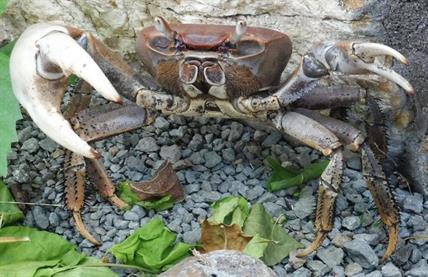



Cardisoma guanhumi
Size
Carapace up to 11cm wide.
Description:
Adults: Males have vastly dimorphic (unequal) claws..the larger claw's slender fingers may be longer than the carapace - up to 15cm. Pale grey, brown or bluish. The eyes are stalked. Adults can weigh up to 0.5kg. Adult colours are usually present between 80g and 180g.
Juvenile: Dark violet/ brown with reddish legs. Very young can be sandy brown.
Ecology
Usually close to the sea. Primarily noturnal.Constructs large, deep burrows down to water level. They are omnivores, eating leaves and fruits close to its burrow whilst also eating insects and carrion, also cannibalistic. It finds its food using light and sound detectors. Experiments show that crabs can be drawn out of their burrows to investigate the sound of falling fruit, once out they initiate a search for food. Predatory behavior is released in these crabs by detection of small moving objects. Crabs in the genus Cardisoma are able to detect small vibrations on the ground within the range of 10-1500 Hz and 70 dB. Visual acuity increases with body size due to an increase in both the number and diameter of ommatidia
N.B. if adults have been feeding on the fruit of the Manchineel tree (Hippomane mancinella), the flesh can cause ulceration!
Life Cycle
Mate in the male's burrow. The reproductive cycle is closely linked to seasonal weather patterns and lunar phase. Several spawns per year may occur. Heavy rains in the spring initiate migrations. Females carry the egg mass for ~2 weeks until ready to hatch, then migrate to the sea to release the hatching lrvae into the zooplankton. Eggs hatch into free swimming larvae with 5 zoeal stages and 1 postlarval or megalopa stage. Typical development time from hatching to the first crabs stage is 42 days under laboratory conditions; however, this time may be much shorter in wild specimens.
C. guanhumi is a slow-growing species compared to most other crabs. It requires more than 60 molts - roughly three times more than other species of crab - to reach its full size. The crab will generally seal the exit to its burrow using mud, 6-10 days before it molts, in order to protect itself from predators.
Carapace up to 11cm wide.
Description:
Adults: Males have vastly dimorphic (unequal) claws..the larger claw's slender fingers may be longer than the carapace - up to 15cm. Pale grey, brown or bluish. The eyes are stalked. Adults can weigh up to 0.5kg. Adult colours are usually present between 80g and 180g.
Juvenile: Dark violet/ brown with reddish legs. Very young can be sandy brown.
Ecology
Usually close to the sea. Primarily noturnal.Constructs large, deep burrows down to water level. They are omnivores, eating leaves and fruits close to its burrow whilst also eating insects and carrion, also cannibalistic. It finds its food using light and sound detectors. Experiments show that crabs can be drawn out of their burrows to investigate the sound of falling fruit, once out they initiate a search for food. Predatory behavior is released in these crabs by detection of small moving objects. Crabs in the genus Cardisoma are able to detect small vibrations on the ground within the range of 10-1500 Hz and 70 dB. Visual acuity increases with body size due to an increase in both the number and diameter of ommatidia
N.B. if adults have been feeding on the fruit of the Manchineel tree (Hippomane mancinella), the flesh can cause ulceration!
Life Cycle
Mate in the male's burrow. The reproductive cycle is closely linked to seasonal weather patterns and lunar phase. Several spawns per year may occur. Heavy rains in the spring initiate migrations. Females carry the egg mass for ~2 weeks until ready to hatch, then migrate to the sea to release the hatching lrvae into the zooplankton. Eggs hatch into free swimming larvae with 5 zoeal stages and 1 postlarval or megalopa stage. Typical development time from hatching to the first crabs stage is 42 days under laboratory conditions; however, this time may be much shorter in wild specimens.
C. guanhumi is a slow-growing species compared to most other crabs. It requires more than 60 molts - roughly three times more than other species of crab - to reach its full size. The crab will generally seal the exit to its burrow using mud, 6-10 days before it molts, in order to protect itself from predators.

| Ecological Descriptors | ||||
| Habitat | Size (cm) | Diet | Behaviour | Sex |
| Ter | 11 (carapace) |
Omn | I | F |
Great Land Crab Male
Synonyms:
Duppy
Blue Land Crab
Duppy
Blue Land Crab

215



